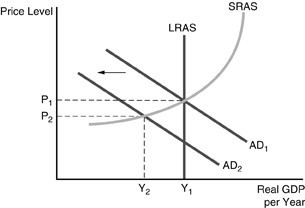 Refer to the above figure. Unexpected contractionary monetary policy has caused the aggregate demand curve to shift to AD2. In the long run
Refer to the above figure. Unexpected contractionary monetary policy has caused the aggregate demand curve to shift to AD2. In the long run
A. the unemployment rate will be smaller than the rate before the expansionary monetary policy.
B. the unemployment rate will be the same rate as before the contractionary monetary policy.
C. the unemployment rate will be larger than the rate before the expansionary monetary policy.
D. the unemployment rate can increase or decrease depending upon how much the LRAS will shift.
Answer: B
You might also like to view...
Identify and explain 4 of the difficulties in making cross-country comparisons in health care outcomes
What will be an ideal response?
According to economic theory, it is often rational for a politician to support special interest groups at the expense of unorganized, widely dispersed groups (for example, taxpayers or consumers)
a. only when the gains that accrue to the special interest group exceed the costs imposed on other voters. b. when nonspecial-interest voters are unconcerned or uninformed about the issue, and campaign funds are readily available from the special interest group. c. only if the government action is socially efficient. d. only if the government action will reduce the monopoly power of business or labor and, thereby, lead to an improvement in the general welfare of consumers.
When workers purchase more leisure and work less at higher wages, the supply curve is
A. vertical. B. horizontal. C. positively sloped. D. backward bending.
According to Pigou, the best way to deal with a negative externality is to
A. tax it. B. allow both parties to negotiate. C. assign liability to the party with the highest cost of prevention. D. assign liability to the party with the lowest cost of prevention.